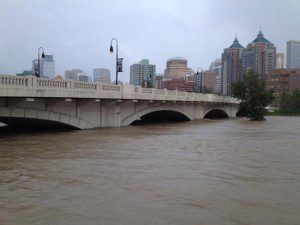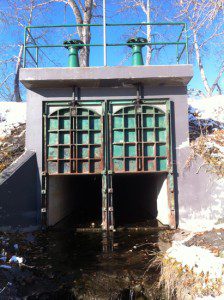
On the third floor of a building in the southwestern quadrant of this major city on the Prairies, sits a non-discript office. Nothing special about its look or identification. Just another downtown Calgary workplace. However, inside resides one of the most precious resources, the city discovered last summer, that helped thousands of its citizens weather perhaps the city’s least predicted natural disaster – the 2013 flood of the Bow River.
“[As many as] 2,159 free counselling sessions were delivered,” the Distress Centre in that Calgary office reported. “Online crisis chats increased 739 per cent,” during the flood.
Over the weekend, I reconnected with an old friend and longtime Calgarian, who updated me on the aftermath of the worst flood in Calgary’s living memory. Diane Jones Konihowski has recently moved into a new role in her multi-faceted career. The former Olympian and Commonwealth Games (pentathlon) gold-medalist, Jones Konihowski, now as senior manager at Distress Centre Calgary, today helps to raise funds and awareness for this 24-hour crisis support service in the city. She recalled the afternoon the flood waters rose to threaten DCC’s downtown offices.

“Our number-one priority was to keep the (phone) lines open,” she explained to me this week. And the volunteers remained on duty until told to evacuate “at 4 p.m. on Friday, June 21, as the Bow River immersed the City of Calgary under a sea of sludge.”
The 211-line, as it’s known, had provided Calgary residents with advice, direction and assistance from a corps of volunteers trained to listen and respond to citizens in distress right up to that time. As most Calgarians on higher ground simply hunkered down with their household reserves of freezer food, battery-operated appliances and characteristic Prairie self-sufficience, those in the lower flood plains along the river faced last-minute evacuations and the stress of losing everything they couldn’t carry out the door with them. Diane said the distress calls were a real test of the DCC volunteers’ training and resiliency.

Earlier in the day, I had strolled with a friend through a downtown area of the city known as Kensington, on the north side of the Bow River. Here almost all city residents and businesses suffered flooded basements, and/or first floors. At the Pages Bookstore in Kensington, however, one employee remembered the store had become nearly surrounded by flood water that weekend, but none of its precious merchandise suffered damage. In contrast, an antiquarian bookstore in the city experienced a deluge and lost most of its inventory.
“Ironically, we could likely have replaced our first-run books,” she said, “but, of course, the antiquarian shop could not.”
That same evening, I happened to attend an in-house party and concert in celebration of the T. Buckley Trio. The residential hosts – a supportive couple in southwest Calgary – wanted their friends and neighbours to enjoy the latest musical collaborations of lead singer/songwriter Tim Buckley and his band members – electric/steel guitarist Tim Leacock and upright bass player Derek Pulliam – as they featured new material from an upcoming album release. Among their new compositions was a song Buckley had composed about the Bow River.
“We’d been working at recording studios in Inglewood at the time the flood began,” Buckley recalled, “and were suddenly told to get out,” and clearly the impressions left by the flood will be deep enough to cut into the grooves of their next CD.
It’s taken four months, but the city has nearly returned to normal after the flood. Following last week’s municipal elections, during which Calgary’s popular mayor, Naheed Nenshi, earned a comfortable re-election, City Council has moved back into its normal surroundings – the old city hall building. The structure underwent extensive repairs to restore the working council chamber in time for this week’s council meeting.
Meanwhile, Calgary city workers continue to repair damage to the Calgary Zoo, among the first victims of the spring flooding. I imagined the panic the rising waters must have inflicted on animals large and small. I shook my head at the barren riverbank where once the zoo’s lush vegetation had sheltered its four-legged residents.

Where the two-legged victims are concerned, Diane Jones Konihowski pointed out her Distress Centre Calgary facility, despite being temporarily evacuated from its offices that June day, was soon back online.
“Within 24 hours (of the evacuation),” she said, “we were back in our building. And over the net six weeks, our call volume increased by 38 per cent … (mostly) concerning housing/accommodation and financial issues.”
Like the invisible scars left on military combat personnel – latterly known as post-traumatic stress disorder – it’s clear that civilians caught in a natural and human tragedy can suffer permanent psychological damage… damage that only trained PTSD professionals can spot and begin to remedy. The obvious scars in Calgary’s infrastructure and downtown landscape will soon fade.
The deeper, invisible ones, may take more time and the patience of trained listeners to erase.